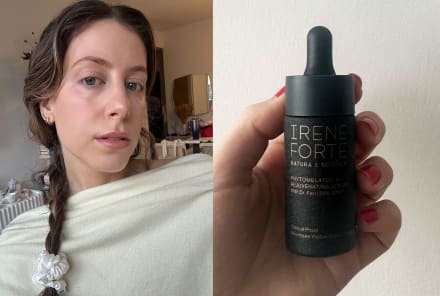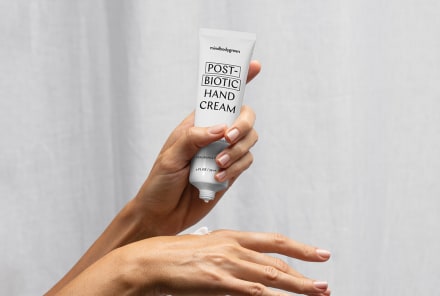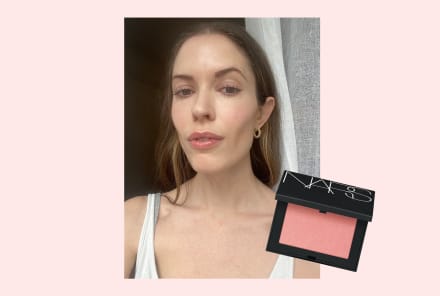Advertisement
Oils, Serums, Toners + Treatments — Here's Exactly How To Layer Your Skin Care Products


The world of natural beauty is expanding in a big way, especially when it comes to skin care. Shops like Credo Beauty, CAP Beauty, and Follain are bringing it mainstream, and as we pointed out in our beauty trend forecast, even larger brands want in on the green action.
With so many options, it's tempting to fill out your shelves with product. Who are we to judge?! Serums, oils, and treatments are especially large categories—which makes sense, since naturals can be just as potent (and sometimes more so) than their conventional counterparts. They're a solid entry into the world of green beauty.
That said, an abundance of product has brought on a "conundrum"—how does one actually effectively include all of these products in his or her routine? Using too many products at once can make skin break out, but did you know that the order in which you use your products matters as well? Similar to double cleansing, layering products in the right sequence may change your skin! It's just like math—kind of—there's an order of operations, the main difference being that there are a few approaches that work to the same end. Avoid wasting product and money, irritating your skin, and rendering other products ineffective by changing up your routine. Here are a few strategies to try:
1. Rotate your treatments.
Minimalists and sensitive skin types, this is for you. "People who are using four to five layers of skin care are adding so many ingredients that a) it's hard to know what's working, b) it's impossible to know what isn't, and c) the skin can only absorb so much in one sitting so it may limit the efficacy of all products," said Sarah Villafranco, M.D., founder of Osmia Organics who also happens to have incredible skin.
If you have sensitive skin, chances are using too many products at once will aggravate it. The best thing to do is to rotate your treatments and serums, just like you would rotate your greens in a morning smoothie. Your skin will benefit from paring back, and you can choose which product you use based on how your skin is feeling. Plus, sticking with one product at a time will give you a better sense of how it reacts with your skin.
2. Use water-based products before oil-based ones.
This is actually the inverse logic behind double cleansing, which makes sense if you want to both stay on the skin and properly absorb. Occlusives, another word for oil- or lipid-based products, create a barrier on the skin, so use toners, hydrosols, and water-based serums before your face oils. That way, your oil will lock in any moisture, leaving skin smooth and supple. "My only layering strategy is [w]ater-based products come before oil-based products," Dr. Villafranco agreed.
3. And then, go lightest to heaviest.
No. 2 still holds true—if you apply occlusives, first use water products. But what happens when you're using multiple waters or multiple oils? Layer them lightest to heaviest. This isn't a flawless method because it's impossible to know exact ratios of ingredients in a product, but you can make an educated guess.
Like food labels, ingredient lists on beauty products start with the highest volume and go to the lowest. Knowing this can help you understand the composition of your product.
Beyond that, here are some basic guardrails that help categorize active ingredients by size. Of course, not all sourcing and processing are the same, but this should give you a general idea:
Lightweight oils are also often categorized as "dry." They include rosehip, moringa, maracuja, baobab, marula, and apricot kernel oil.
Mediumweights are great for normal skin and fall in between light and heavy. They include argan, noni, and squalane.
Heavyweight oils are more viscous and helpful for dryer skin types, but beware—for some, they are comedogenic. They include coconut oil, olive oil, and avocado oil.
4. Prioritize your products.
Last but not least, prioritize your products by their function. If you're using a retinol at night for acne or anti-aging purposes, for example, apply it before any other products. The product closest to the skin will penetrate it most deeply, even if you layer well.
Dermatologist Cybele Fishman, M.D., shares her routine, which falls in line with her recommendations to patients. "Typically, I use an antioxidant serum in the morning and put my Elta MD UV Clear moisturizer with SPF on top. In this scenario, you want to put on the antioxidant first so it gets to the layer of the skin you are trying to prevent oxidation in—in simpler terms, the anti-aging ingredient first. If you are using a retinol at night, you want to put that on first, and the serum on top would be for moisture retention, like a hyaluronic acid serum."
For more life-changing beauty tips, check out the one step that's missing from your routine and a crash course in double cleansing.
Watch Next
Enjoy some of our favorite clips from classes
Enjoy some of our favorite clips from classes
What Is Meditation?
Mindfulness/Spirituality | Light Watkins
Box Breathing
Mindfulness/Spirituality | Gwen Dittmar
What Breathwork Can Address
Mindfulness/Spirituality | Gwen Dittmar
The 8 Limbs of Yoga - What is Asana?
Yoga | Caley Alyssa
Two Standing Postures to Open Up Tight Hips
Yoga | Caley Alyssa
How Plants Can Optimize Athletic Performance
Nutrition | Rich Roll
What to Eat Before a Workout
Nutrition | Rich Roll
How Ayurveda Helps Us Navigate Modern Life
Nutrition | Sahara Rose
Messages About Love & Relationships
Love & Relationships | Esther Perel
Love Languages
Love & Relationships | Esther Perel

















